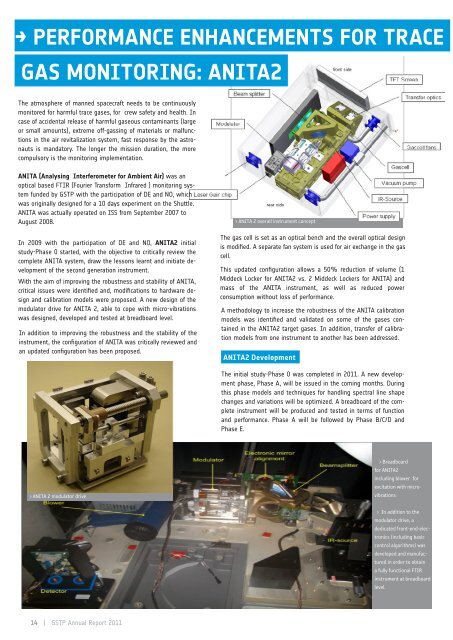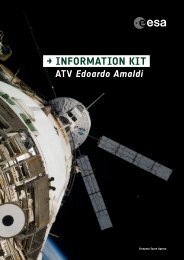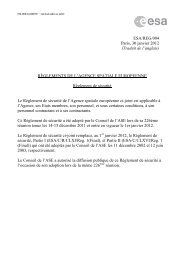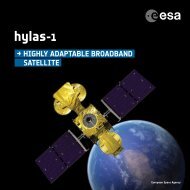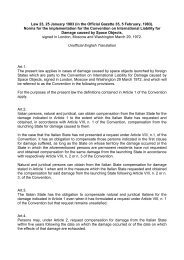→ GSTP ANNUAL REPORT 2011 - ESA
→ GSTP ANNUAL REPORT 2011 - ESA
→ GSTP ANNUAL REPORT 2011 - ESA
Create successful ePaper yourself
Turn your PDF publications into a flip-book with our unique Google optimized e-Paper software.
<strong>→</strong> PerformAnCe enhAnCemenTS for TrACe<br />
GAS moniTorinG: AniTA2<br />
The atmosphere of manned spacecraft needs to be continuously<br />
monitored for harmful trace gases, for crew safety and health. In<br />
case of accidental release of harmful gaseous contaminants (large<br />
or small amounts), extreme off-gassing of materials or malfunctions<br />
in the air revitalization system, fast response by the astronauts<br />
is mandatory. The longer the mission duration, the more<br />
compulsory is the monitoring implementation.<br />
AniTA (Analysing interferometer for Ambient Air) was an<br />
optical based FTIR (Fourier Transform Infrared ) monitoring system<br />
funded by <strong>GSTP</strong> with the participation of DE and NO, which<br />
was originally designed for a 10 days experiment on the Shuttle.<br />
ANITA was actually operated on ISS from September 2007 to<br />
August 2008.<br />
In 2009 with the participation of DE and NO, AniTA2 initial<br />
study-Phase 0 started, with the objective to critically review the<br />
complete ANITA system, draw the lessons learnt and initiate development<br />
of the second generation instrument.<br />
With the aim of improving the robustness and stability of ANITA,<br />
critical issues were identified and, modifications to hardware design<br />
and calibration models were proposed. A new design of the<br />
modulator drive for ANITA 2, able to cope with micro-vibrations<br />
was designed, developed and tested at breadboard level.<br />
I n a d d i t i o n t o i m p r o v i n g t h e r o b u s t n e s s a n d t h e s t a b i l i t yo f t h e<br />
instrument, the configuration of ANITA was critically reviewed and<br />
an updated configuration has been proposed.<br />
> Modulator Drive<br />
> ANITA 2 modulator drive<br />
14 | <strong>GSTP</strong> Annual Report <strong>2011</strong><br />
> ANITA 2 overall instrument concept<br />
The gas cell is set as an optical bench and the overall optical design<br />
is modified. A separate fan system is used for air exchange in the gas<br />
cell.<br />
This updated configuration allows a 50% reduction of volume (1<br />
Middeck Locker for ANITA2 vs. 2 Middeck Lockers for ANITA) and<br />
mass of the ANITA instrument, as well as reduced power<br />
consumption without loss of performance.<br />
A methodology to increase the robustness of the ANITA calibration<br />
models was identified and validated on some of the gases contained<br />
in the ANITA2 target gases. In addition, transfer of calibration<br />
models from one instrument to another has been addressed.<br />
AniTA2 Development<br />
The initial study-Phase 0 was completed in <strong>2011</strong>. A new development<br />
phase, Phase A, will be issued in the coming months. During<br />
this phase models and techniques for handling spectral line shape<br />
changes and variations will be optimized. A breadboard of the complete<br />
instrument will be produced and tested in terms of function<br />
and performance. Phase A will be followed by Phase B/C/D and<br />
Phase E.<br />
> Breadboard<br />
for ANITA2<br />
including blower for<br />
excitation with microvibrations<br />
> In addition to the<br />
modulator drive, a<br />
dedicated front-end-electronics<br />
(including basic<br />
control algorithms) was<br />
developed and manufactured<br />
in order to obtain<br />
a fully functional FTIR<br />
instrument at breadboard<br />
level.


